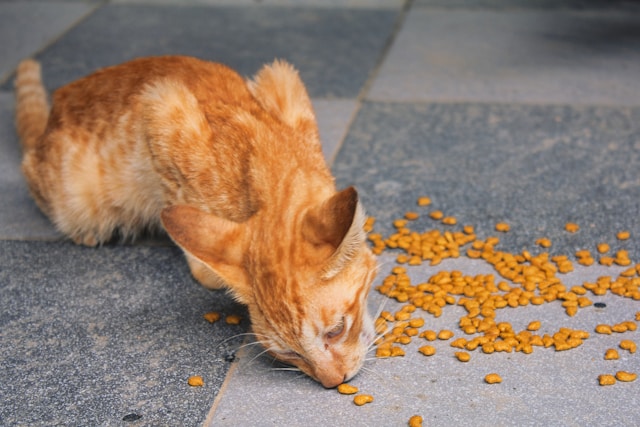Understanding the science behind cat nutrition is crucial for ensuring your feline friend stays healthy and happy. Cats have unique dietary needs that differ significantly from humans and other animals. Proper nutrition is essential for their overall health, growth, and longevity. This guide explores the fundamental aspects of cat nutrition, including essential nutrients, dietary needs, and tips for choosing the best food for your cat.
Understanding Cat Nutrition
The Unique Nutritional Needs of Cats
Cats are obligate carnivores, meaning they require a diet primarily composed of animal protein. Unlike omnivores, they cannot thrive on plant-based diets alone. Their bodies are adapted to metabolize proteins and fats from animal sources efficiently, making these nutrients crucial for their health.
Key Nutrients for Cats
- Proteins: Proteins are essential for building and repairing tissues, maintaining muscle mass, and supporting immune function. Cats require high-quality animal-based proteins, such as chicken, beef, and fish, in their diet.
- Fats: Fats provide a concentrated source of energy and support various bodily functions, including the absorption of fat-soluble vitamins. Essential fatty acids, like omega-3 and omega-6, are crucial for healthy skin and coat.
- Carbohydrates: While cats need fewer carbohydrates compared to dogs and humans, they still benefit from a small amount of easily digestible carbs for energy. However, their diet should primarily focus on proteins and fats.
- Vitamins: Cats require specific vitamins, including vitamin A, vitamin D, and B vitamins, for various bodily functions. For example, vitamin A supports vision and immune health, while vitamin D aids in calcium absorption.
- Minerals: Essential minerals such as calcium, phosphorus, potassium, and magnesium are vital for bone health, nerve function, and overall metabolic processes.
- Water: Hydration is crucial for all bodily functions. Cats should have access to fresh, clean water at all times to prevent dehydration and support kidney function.
Types of Cat Food
Dry Cat Food
- Convenience: Dry cat food, or kibble, is easy to store and can help with dental health by reducing tartar buildup.
- Nutritional Balance: High-quality dry foods offer balanced nutrition, but ensure they contain adequate moisture or supplement with wet food to maintain hydration.
Wet Cat Food
- Hydration: Wet food provides higher moisture content, which is beneficial for cats with urinary tract issues or those prone to dehydration.
- Palatability: Many cats find wet food more appetizing and may be more likely to eat a balanced diet when fed wet food.
Raw and Homemade Diets
- Raw Diets: Some cat owners opt for raw or “BARF” (Biologically Appropriate Raw Food) diets, which mimic a cat’s natural prey. However, these diets require careful preparation to ensure nutritional balance and safety.
- Homemade Diets: Homemade diets allow for customization but must be carefully planned to meet all of a cat’s nutritional needs. Consult a veterinarian or pet nutritionist before transitioning to a homemade diet.
Specialty Diets
- Medical Diets: Cats with specific health conditions, such as diabetes or kidney disease, may require specialty diets formulated to manage their conditions.
- Allergen-Free Diets: For cats with food allergies or intolerances, allergen-free or limited-ingredient diets can help prevent adverse reactions.
Reading Cat Food Labels
Understanding Ingredients
- Protein Sources: Look for specific animal proteins, such as chicken or fish, listed as the first ingredient. Avoid foods with vague terms like “meat by-products” or “animal digest.”
- Fat Content: Ensure the food contains quality fat sources, such as chicken fat or fish oil, which provide essential fatty acids.
- Carbohydrate Sources: Check for digestible carbohydrate sources like rice or potatoes. Avoid excessive fillers like corn or wheat.
Nutritional Analysis
- Guaranteed Analysis: Review the guaranteed analysis on the label, which provides information on the percentage of crude protein, fat, fiber, and moisture in the food.
- Nutritional Adequacy Statement: Ensure the food meets the standards set by the Association of American Feed Control Officials (AAFCO) for complete and balanced nutrition.
Dietary Considerations
Age and Life Stage
- Kittens: Kittens require higher levels of protein and fat to support growth and development. Choose a kitten-formulated food for optimal nutrition.
- Adults: Adult cats need a balanced diet to maintain their weight and health. Avoid overfeeding and provide age-appropriate nutrition.
- Seniors: Senior cats may benefit from diets formulated for older cats, which may include added joint support and lower calorie content.
Health Conditions
- Obesity: For overweight cats, choose a weight management formula with controlled calories and increased fiber to help with weight loss.
- Dental Health: Foods designed to support dental health can help reduce plaque and tartar buildup, contributing to overall oral hygiene.
- Kidney Disease: Cats with kidney disease require diets low in phosphorus and protein, which should be prescribed by a veterinarian.
Transitioning to a New Diet
Gradual Transition
- Slow Introduction: Introduce new food gradually over 7 to 10 days by mixing it with the current food. This helps your cat adjust and reduces the risk of digestive upset.
- Monitor Reactions: Observe your cat’s reaction to the new food, including changes in appetite, stool consistency, and overall health.
Consistency
- Feeding Schedule: Maintain a consistent feeding schedule to help regulate your cat’s digestion and avoid overfeeding.
- Portion Control: Follow feeding guidelines provided on the food packaging or by your veterinarian to ensure proper portion sizes.
Common Misconceptions About Cat Nutrition
Myth: Cats Can Eat the Same Food as Dogs
- Different Needs: Cats have specific nutritional requirements that differ from dogs. Cat food is formulated to meet these needs, while dog food may lack essential nutrients for cats.
Myth: Grain-Free Diets Are Always Better
- Balanced Diet: While some cats may have grain sensitivities, most can tolerate grains. Focus on the overall quality and balance of the diet rather than the absence of grains.
Myth: All Human Foods Are Safe for Cats
- Toxic Foods: Many human foods, such as chocolate, onions, and garlic, are toxic to cats. Stick to cat food and treats formulated specifically for felines.
Conclusion
Understanding the science behind cat nutrition is essential for providing your feline companion with a balanced and healthy diet. By focusing on high-quality protein sources, essential nutrients, and appropriate food types, you can ensure that your cat receives the nutrition they need to thrive. Be attentive to their specific dietary needs based on age, health conditions, and lifestyle, and consult with your veterinarian to make informed decisions about their diet. With the right nutrition, your cat will enjoy a long, healthy, and happy life.











Leave a Reply